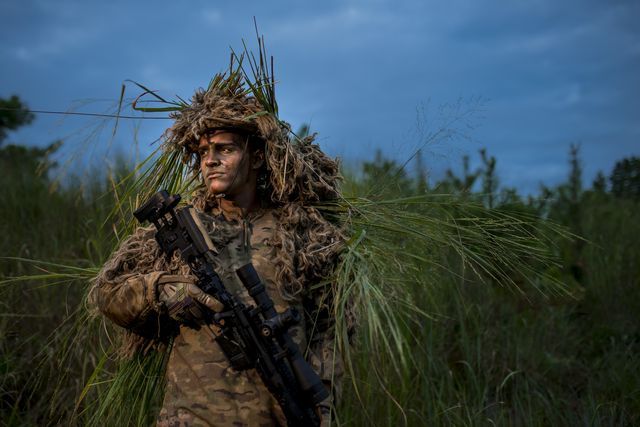The U.S. Army is on the verge of testing new specialized suits designed to let snipers approach their targets while blending in with their surroundings. The new improved ghillie system (IGS) will offer significant advantages over the older system while still making Army snipers look like vegetable men from another world.
During World War I, Scottish marksmen wore what they called “ghillie” suits to camouflage themselves on the battlefield. Designed to break up the profile of an ordinary human and make the user look like a large bush, the “ghillie” (Scottish slang for “man”) were inspired by suits Scottish gamekeepers wore to catch poachers.
Despite their extremely comfortable appearance, with lots of puffy fabric, strips of cloth, and a generally soft look, ghillie suits are not fun to wear. John Plaster, author of The Ultimate Sniper, describes them as “hot, bulky, heavy--murderously heavy when wet.” Plaster states the ghillie wearers experience “stifling heat from layers of thick burlap” and recommends drinking plenty of water to avoid heat exhaustion while wearing a ghillie.
Ghillie suits are also dangerous to the wearer in other ways. Plaster describes them as “like an old Christmas tree waiting for a spark," and relates the story of a sniper whose suit went up in flames in a matter of seconds after a spark from a smoke grenade.
Now, the Army is testing a new suit designed to deal with these issues. The Army has selected three candidates for the new improved ghillie system (IGS) and according to the service’s PEO Soldier program, lab and field testing will commence in November. The Army will test the suit to see if it reduces a sniper’s infrared signature in night vision devices, how loud it is in the field, and and test its tear resistance and fire resistance. The Army wants a material with a “lower burn rate” than burlap with no melting or dripping.
The new suit will address the heat and weight problem by using lightweight, breathable textiles designed to allow body heat to escape. The system should not weigh more than five pounds. The modular system will wear over the standard U.S. Army field uniform and consist of leggings, a cape, sleeves, a veil, and so on. Soldiers will be able to wear all or part of the uniform.
The IGS moves into limited field trials next Spring, as instructors at the U.S. Army Sniper School at Fort Benning, Georgia will test the suits. The Army will buy up to 3,500 of the winning suits to equip snipers service-wide.
In the future, the U.S. Army wants ghillie suits that prevent the user from standing out in night vision and “chameleon like camouflage using color-shifting nanotechnology fabrics” and “three-dimensional, continuously multidirectional cloaking." Right, we’ve seen Predator too.
Source: U.S. Army

Kyle Mizokami is a writer on defense and security issues and has been at Popular Mechanics since 2015. If it involves explosions or projectiles, he's generally in favor of it. Kyle’s articles have appeared at The Daily Beast, U.S. Naval Institute News, The Diplomat, Foreign Policy, Combat Aircraft Monthly, VICE News, and others. He lives in San Francisco.















